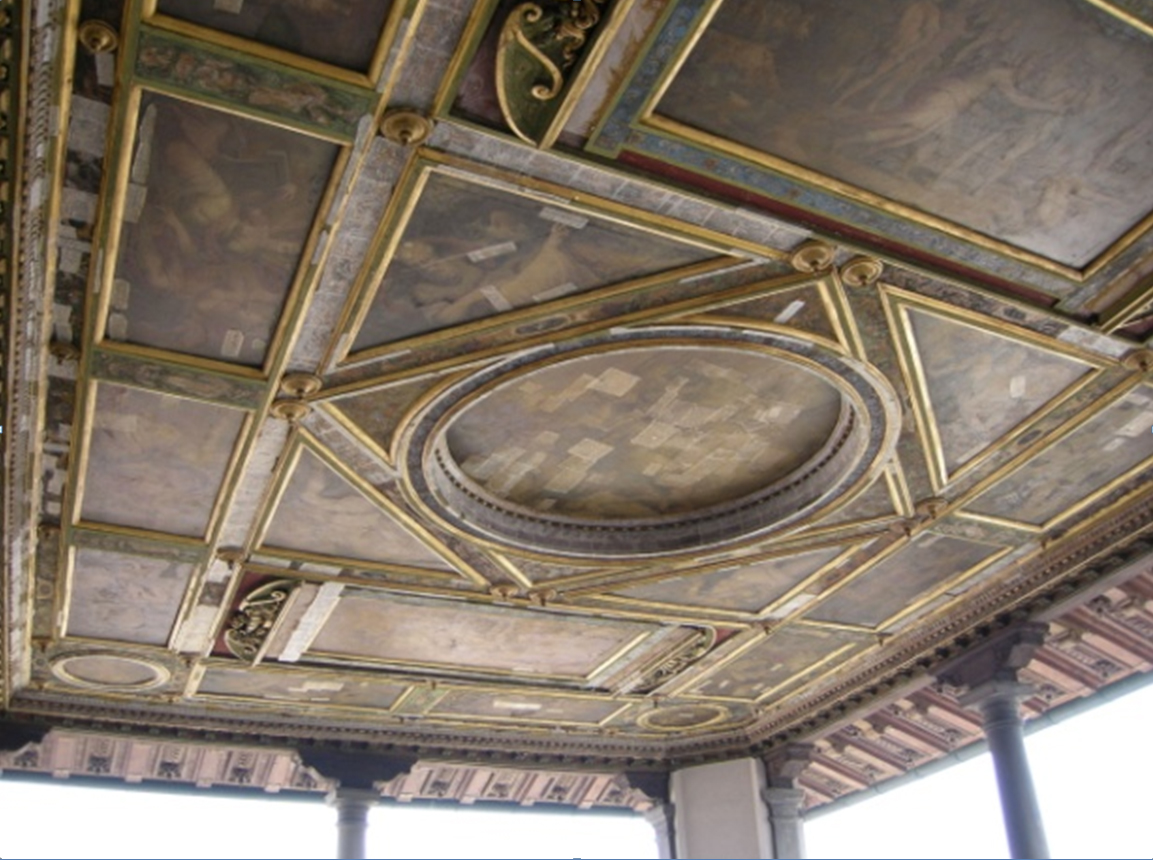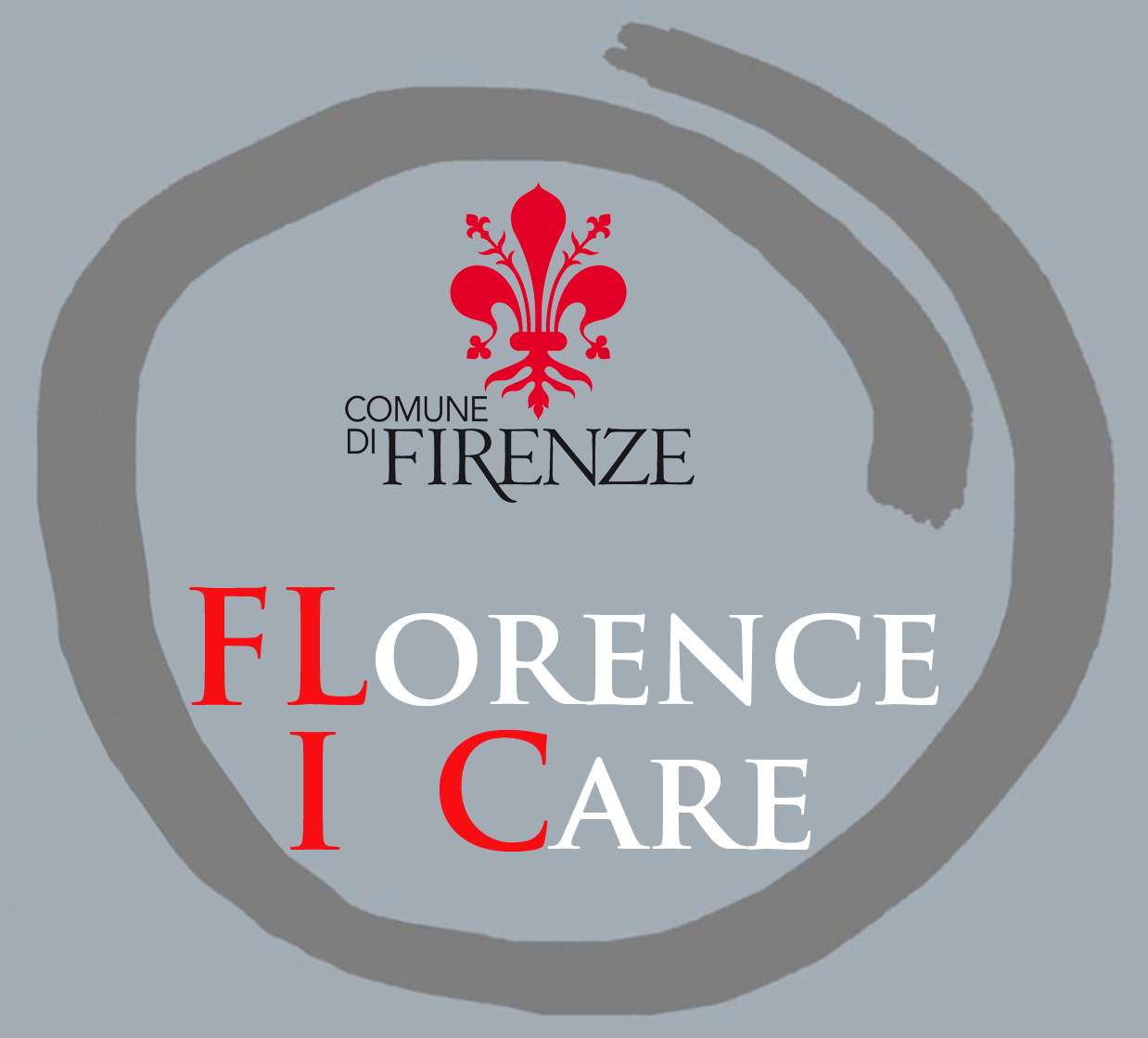Palazzo Vecchio - terrazza di Saturno
Restauro soffitto ligneo nel quartiere degli Elementi/Restoration of the wooden ceiling in the Apartment of the Elements

Si potrebbe sostenere che un edificio è adeguato al suo contesto se
incarna i valori più desiderabili e le ambizioni più elevate del momento
e del luogo in cui si trova: un edificio che serve da deposito di un ideale
non utopico.
Alain de Botton
L’opera, che risente di tutte le negatività dovute al fatto che si trova in esterno, ha subito numerose nei secoli numerose traversie, fra le quali addirittura un incendio. I continui sbalzi climatici, la copiosità dei depositi inquinanti, l’umidità di condensa che concorre ad attivarne il potere corrosivo hanno nel tempo cancellato gran parte delle figurazioni esistenti nelle tavole che costituiscono i lacunari. Nel 2000, per porre fine alla perdita di frammenti decoesi di pellicola pittorica che si distaccavano da numerose porzioni, fu stesa una velinatura ancor oggi visibile, che se ha eliminato tali perdite adesso, per il troppo tempo che è rimasta in situ, rischia di divenire essa stessa un pericoloso fenomeno degradante. Come per altri analoghi manufatti anche questo soffitto risente del naturale invecchiamento del materiale ligneo che ne costituisce le travature, i cui effetti sono accelerati dal clima sia secco che umido. Le tavole dipinte che fungono da lacunari sono caratterizzate da deformazioni e ritiri che hanno causato fessurazioni anche importanti, con conseguente perdita di materiale pittorico. Le figurazioni presentano ampie lacune e ridipinture e notevoli alterazioni cromatiche, quasi certamente non reversibili.
The work, which suffers from all the negativity due to the fact that is located outdoors, has undergone numerous vicissitudes during several centuries, among which even a fire. The ongoing climatic changes, the abundance of pollutant deposits, moisture condensation that helps to activate the corrosive power over time have erased much of the existing figures in the tables that make up the coffers. In 2000, to put an end to the loss of detached fragments of paint film that marked several portions, was lied a velinatura still visible today, that, if it has eliminated those losses for too long remained in situ, now it risks becoming itself a dangerous degrading phenomenon. As with other similar artifacts even this ceiling reflects the natural aging of the wooden material that forms the roof beams, the effects of which are accelerated by the climate both dry and wet. The painted panels that serve as coffers are characterized by deformation and shrinkage that have also caused important cracks, resulting in loss of pictorial material. The figures present large gaps and repainting and significant discoloration, almost certainly not reversible.
Valore dell’intervento/Value of intervention: € 750.000,00
Durata dei lavori/Time Line: 365 giorni/days
Tipologia dell’intervento: sia in fase di pulitura che in fase di restituzione estetica sarà indispensabile tener conto della storicizzazione delle integrazioni pittoriche susseguitesi nel corso del tempo per recuperare le vaste lacune del tessuto pittorico. Potrebbe essere necessario conservarle ove possibile, anche solo parzialmente, per non mantenere almeno l’attuale livello di leggibilità delle opere raffigurate nelle varie parti del soffitto ligneo. L’intervento consisterà sia nella revisione e nel restauro dell’intera superficie dipinta e della relativa superficie a tergo, che nella revisione, pulitura, disinfezione ed eventuale ripristino della funzionalità della struttura portante. Tutte le opere previste sono classificabili in categoria OS2a, conservazione e restauro di superfici decorate.
Type of intervention: Both during cleaning than in aesthetics return phase, we will have to take account of the integration of historicizing painting that continued over the times to recover the vast gaps in the painting process. You may need to keep them if possible, even partially, at least not to maintain the current level of readability of the works shown in the various parts of the wooden ceiling. The project would consist in both review and restoration of the entire painted surface and the related back surface, and in the review, cleaning, disinfection and eventual restoration of the functionality of the supporting structure. All planned works are classified in category OS2a, conservation and restoration of decorated surfaces.
Attrattività: alta, per possibilità di allestimento dell’area di deposito del cantiere sullo spazio esterno, prospiciente piazza della Signoria.
Attractiveness: high, for the possibility of setting up the storage area of the construction site on outer space, overlooking Piazza della Signoria.
Notizie storico-artistiche: il Terrazzo di Saturno è compreso nel Quartiere degli Elementi di Palazzo Vecchio, che si trova all’ultimo piano di un corpo di fabbrica collegato ad est con il nucleo edilizio del Salone dei Cinquecento, e che Battista di Marco del Tasso, fra il 1551 e il 1554, ottenne dall’inglobamento e dalla trasformazione delle strutture trecentesche preesistenti. La decisione di trasformare gli edifici trecenteschi invece di abbatterli, fu attribuita dal Vasari allo stesso Cosimo I, che in tal modo, nel mostrare la sua propensione ad una gestione economica e razionale dei beni edilizi più importanti della città, intendeva comunicare che la sua azione di governo sarebbe stata analoga, e quindi avrebbe migliorato quella dei suoi predecessori senza distruggerne lo spirito. Il Terrazzo, la cui costruzione a cura del Tasso era terminata nel 1555, ebbe il suo soffitto intagliato e dipinto ad opera di Giorgio Vasari, il cui aiuto fondamentale in questo ambiente fu Giovanni Stradano. I dipinti hanno come tema Saturno e allegorie delle quattro età dell’uomo, delle dodici ore del giorno e dodici della notte, e degli elementi: Aria, Acqua, Terra e Fuoco.
Historical and artistic information:The Terrace of Saturn is included in the Apartment of the Elements of Palazzo Vecchio, which is located on the top floor of a building body connected to the east with the core building of the Salon of the 500. Battista of Marco del Tasso, between 1551 and 1554, obtained it by the incorporation and by the transformation of the existing fourteenth century structures. The decision to transform the fourteenth century buildings instead of knock them down, was attributed by Vasari at the same Cosimo I, who in doing so, to show his propensity to economic management and rational construction of the city’s most important assets, intended to communicate that his government actions would be similar, and therefore would have improved those of his predecessors without destroying the spirit. The Terrace, whose construction was completed by Tasso in 1555, had its ceiling carved and painted by Giorgio Vasari, where the help of Giovanni Stradano was crucial in this environment. The paintings have as theme Saturn and allegories of the four ages of man, of the twelve hours of the day and twelve of the night, and of the elements: Air, Water, Earth and Fire.
